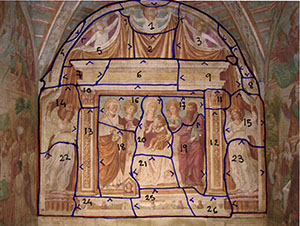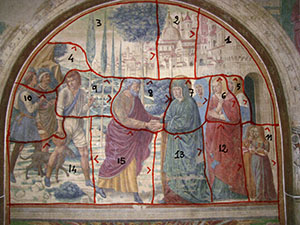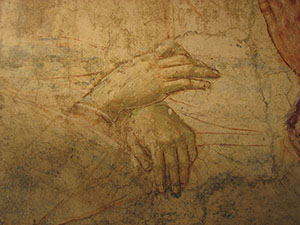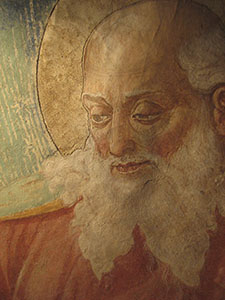back to the list of in-depth studies

The 26 days on the back wall of the Tabernacle of the Madonna of the Cough, Castelfiorentino.

The 15 days of the scene depicting Encounter of Joachim and Anne near the Porta Aurea (Golden Gate), Tabernacle of the Visitation, Castelfiorentino.

Tabernacle of the Madonna of the Cough, detail of the hands in the scene depicting the death of the Madonna in which the preparatory drawing is visible with a clear light/dark contrast.

Detail showing the use of string, a compass and direct engraving or the action of the string against the wet plaster.
The tabernacles of the Madonna of the Cough (1484) and the Visitation (1491) were painted in the fully-matured style of Benozzo Gozzoli, at a time when the painter had a full bag of technical knowledge extending well beyond what he had acquired and been handed down in the painting workshops of his Florentine contemporaries.
By 1459, he had already painted the Magi Chapel in the Medici Riccardi Palace in Florence using a combined technique that was based on a fresco, but with finishing touches added in tempera and oil-based paints.
With regards to the frescoes of the two Castelfiorentino tabernacles, it is difficult to identify the dry finishing with any certainty because the surface of the paintings was altered during the ‘strappo’ (detachment) removal of the frescoes.
Through chemical analysis and by studying the plaster of the remaining structural walls of the Madonna of the Cough tabernacle, it is believed that Benozzo would begin by spreading a arriccio (rendering) with a thickness of 6/8 mm to serve as the drawing surface for his preparatory drawings (sinopia).
Until very recently, as a matter of fact, it was believed that preparatory cartooning had been used in the tabernacle instead of sinopia painting. Some testing that was carried out in October 2008, however, unveiled a sinopia of the Madonna nursing her Child.
Next, the painter would apply just enough pictorial plaster for one day’s work. This layer of plaster, composed of lime and riverbed sand, was well drawn and beaten with a thickness of about 5/7 mm.
Using a grazing light, a close-up analysis of the picture’s surface revealed the overlapping junctures that divided each day’s work from the next, making it possible to reconstruct the work's progression over time and the number of work days required for each scene.
In this way it was determined that the scene representing Madonna with Child and Saints, found on the back wall of the Madonna of the Cough tabernacle, required 26 days of work, while the Encounter of Joachim and Anne near the Porta Aurea scene in the Visitation tabernacle took 15 days. The actual number of work days required was undoubtedly higher, taking into account the additional time needed for dry finishing.
Benozzo painted directly on fresh plaster with a full brush of green, red or yellow ochre diluted in water before using ‘verdaccio’ for the chiaroscuro, in accordance with the Florentine tradition so well described in Cennino Cennini’s volume on art and painting.
The preparatory drawing, complete with chiaroscuro, is visible where the parts finished in tempera have fallen off (for example, the details of the hands in the scene of the death of the Madonna, and the Madonna’s robes in the fake alter piece on the back wall, which had to absorb azurite applied with tempera).
Some of the artist's own modifications can also be observed. For instance, the left arm of Saint Mark in the Madonna of the Cough tabernacle was at first drawn larger than the final version.
The architectural features, the perspective arches that frame the scene and the halos were all drafted with the help of a cord and a protractor and with direct incisions, or by pounding the cord into fresh plaster.
No signs of cartooning were found, nor of spolvero (dusting); all of the figures and decorations were drawn and painted directly on fresh plaster.
The pigments employed were the ones commonly in use at the time for painting frescoes: yellow ochre, red ochre, earth green, San Giovanni white - and were sometimes applied quite thickly; for the blues, chemical analysis confirmed the use of azurite.
To make the highlights stand out, white lead was used (on the yellow robes of Joachim and on the Evangelists Mark and Luke in the Visitation tabernacle), but over time it darkened, becoming brownish due to oxidation of the white lead.
The gilding of the halos (of which only a few traces remain), the stars and the decorations were carried out by applying gold leaf.
On the ribbing of the Madonna of the Cough tabernacle, the gilding on the flower pistils was applied on a sealing wax paste to heighten the relief effect.
The results of the restoration and the first conclusions of the chemical investigation have confirmed that the painting technique was extremely refined: in order to obtain particular chromatic valences and highlighting, Benozzo did not hesitate to mix the purest fresco techniques with tempera, special finishing and gilding.
Fabrizio Iacopini